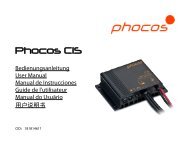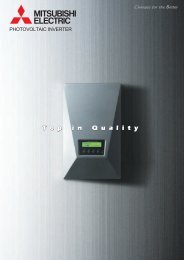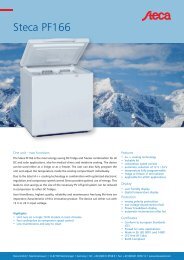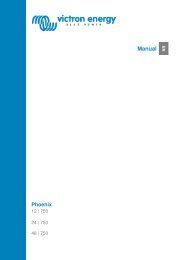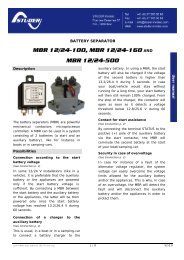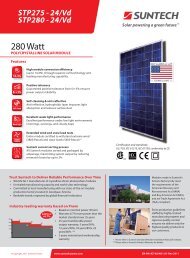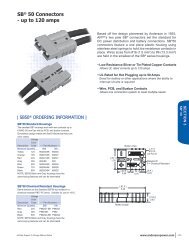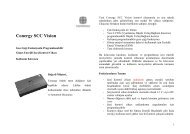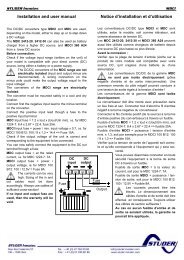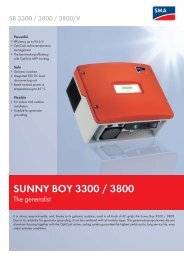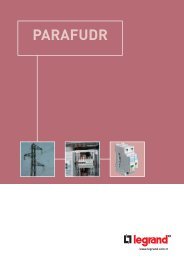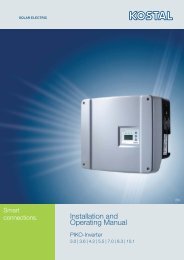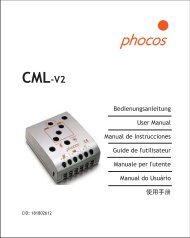You also want an ePaper? Increase the reach of your titles
YUMPU automatically turns print PDFs into web optimized ePapers that Google loves.
<strong>gel</strong> AND <strong>agm</strong> BATTERIESwww.victronenergy.comDisadvantages of the traditional 3-step charge characteristic:• During the bulk phase the current is kept at a constant <strong>and</strong> often high level, even after the gassingvoltage (14,34 V for a 12 V battery) has been exceeded. This can lead to excessive gas pressure in thebattery. Some gas will escape trough the safety valves, reducing service life.• Thereafter the absorption voltage is applied during a fixed period of time, irrespective of how deepthe battery has been discharged previously. A full absorption period after a shallow discharge willovercharge the battery, again reducing service life. (a. o. due to accelerated corrosion of the positiveplates)• Research has shown that battery life can be increased by decreasing float voltage to an even lowerlevel when the battery is not in use.11. Battery charging: longer battery life with Victron 4-step adaptive chargingVictron developed the adaptive charge characteristic. The 4-step adaptive chare curve is the result of years ofresearch <strong>and</strong> testing.The Victron adaptive charge curve solves the 3 main problems of the 3 step curve:• Battery Safe modeIn order to prevent excessive gassing, Victron has invented the ‘Battery Safe Mode’. The battery SafeMode will limit the rate of voltage increase once the gassing voltage has been reached. Research hasshown that this will reduce internal gassing to a safe level.• Variable absorption timeBased on the duration of the bulk stage, the charger calculates how long the absorption time shouldbe in order to fully charge the battery. If the bulk time is short, this means the battery was alreadycharged <strong>and</strong> the resulting absorption time will also be short, whereas a longer bulk time will alsoresult in a longer absorption time.• Storage modeAfter completion of the absorption period the battery should be fully charged, <strong>and</strong> the voltage islowered to the float or st<strong>and</strong>by level. If no discharge occurs during the next 24 hours, the voltage isreduced even further <strong>and</strong> the battery goes into storage mode. The lower storage voltage reducescorrosion of the positive plates.Once every week the charge voltage is increased to the absorption level for a short period tocompensate for self discharge (Battery Refresh mode).12. Battery charging in case of st<strong>and</strong>by use: constant voltage float chargingWhen a battery is not frequently deeply discharged, a 2-step charge curve can be used. During the first phasethe battery is charged with a limited current (the bulk phase). Once a preset voltage has been reached thebattery is kept at that voltage (the float phase).This charge method is used for starter <strong>batteries</strong> in vehicles, <strong>and</strong> in uninterruptible power supplies (UPS).Fig. 4: Four-step adaptive charge curve13. Optimum charge voltage of Victron VRLA <strong>batteries</strong>The recommended charge voltage settings for a 12 V battery are shown in table 3.14. Effect of temperature on charging voltageThe charge voltage should be reduced with increased temperature. Temperature compensation is required when thetemperature of the battery is expected to be less than 10°C / 50°F or more than 30°C / 85°F during long periods of time.The recommended temperature compensation for Victron VRLA <strong>batteries</strong> is -4 mV / Cell (-24 mV /°C for a 12 V battery).The centre point for temperature compensation is 20°C / 70°F.30



